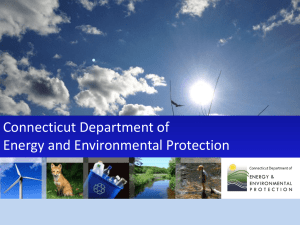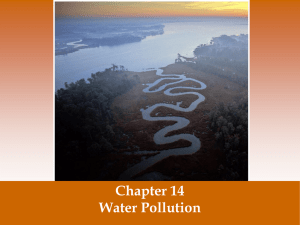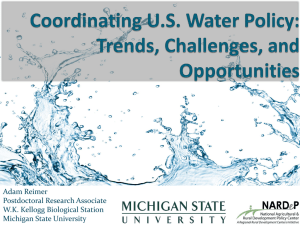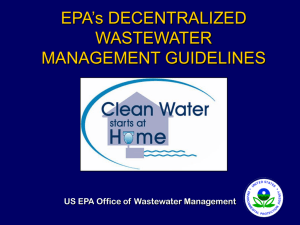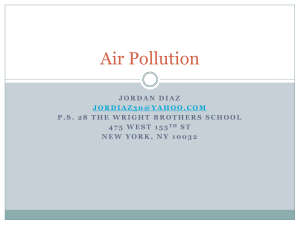Part H (Drainage and Waste Water Disposal) of the Building
advertisement
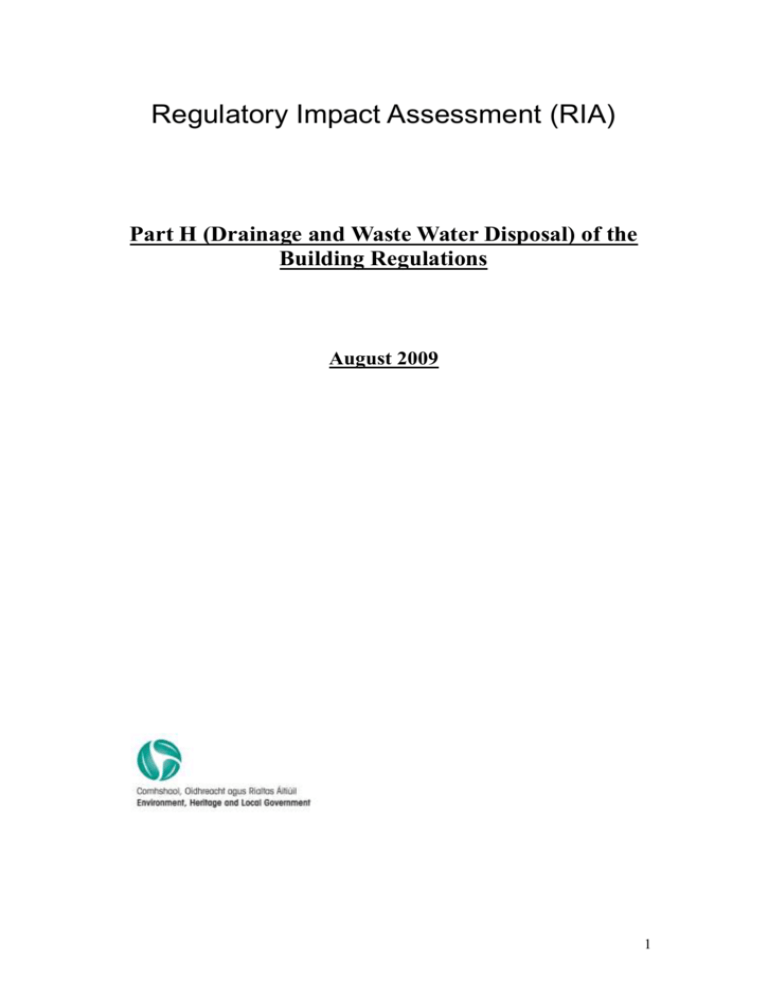
Regulatory Impact Assessment (RIA) Part H (Drainage and Waste Water Disposal) of the Building Regulations August 2009 1 Section 1: Context 1.1 Policy Context The forthcoming EU Directive on ‘the Protection of Groundwater Against Pollution and Deterioration’ (Groundwater Daughter Directive) provides the detail on the means by which the Water Framework Directive (WFD) requirements to prevent and control groundwater pollution (Article 17) are met. In particular, it sets out criteria and procedures for assessing groundwater chemical status and includes identification of any significant and sustained upward trends and the reversal of such trends where they are posing an environmental risk. The Directive outlines the basis for establishing measures to prevent or limit the input of pollutants into groundwater. Account must be taken not only of the need to protect groundwater for environmental reasons, but also for human health reasons. While the Groundwater Daughter Directive emphasises the relevance of protecting groundwater, so that the environment and groundwater-dependent ecosystems are not impacted detrimentally, it also broadens the remit of the WFD, by mentioning human health as an issue that must be considered. Groundwater is an important natural resource in Ireland; both in terms of yield and water quality. It is an important source of drinking water and is utilised in food and industrial processing. Approximately 26 % of the public and private drinking water supply in Ireland is provided by groundwater or spring sources (EPA, 2008a1) with the latter supplying approximately 9% of the total. In certain counties, e.g. Roscommon, the percentage is significantly higher, with groundwater providing approximately 75% of the drinking water (EPA, 20072). (See Figure 1 ‘Groundwater Risk Assessment Map’ in Annex.) Although treated public water supplies and public group water schemes account for approximately 85 % of the total volume of drinking water supplied in Ireland (EPA, 2008a), the actual number of private group water schemes and small private supplies far exceeds that of public supply schemes. The majority of private group schemes and small supplies are reliant on groundwater and spring sources and often have inadequate treatment or, in many cases, no treatment at all. A study has been carried out by the EPA in conjunction with the River Basin Districts which states: “Between 2004-2006, a total of 1,362 individual samples were analysed at 137 monitoring stations. The data indicate that the chemical quality of groundwater is generally good, with only a small number of monitoring points having concentrations greater than the drinking water standards. However, nitrate and phosphate concentrations are significantly higher than background concentrations in places, thereby having the potential to contribute to surface water eutrophication. Also, microbial pathogens are more prevalent, largely from organic waste sources, and can 1 EPA (2008). Irelands Environment 2008: River Water Quality. [Online] Available at: http://www.epa.ie/downloads/pubs/other/indicators/irlenv/43366%20epa%20report%20chap%207.pdf 2 EPA. (2006). Water Quality in Ireland 2006: Key Indicators of the Aquatic Environment [Online] Available at: http://www.epa.ie/downloads/pubs/water/waterqua/epa_water_quality_indicators1.pdf 2 pose a threat to human health. Therefore, greater attention needs to be given to groundwater protection, and in particular to prevention of pollution at source.” Between 2004-06, a total of 1,330 samples were analysed for faecal coliforms at 135 monitoring locations. Positive faecal coliform counts were detected in 338 (25.4%) samples, 143 (10.9%) of which exceeded 10/100 ml. Positive counts were detected at 79 (58.5%) monitoring locations on one or more occasions during the reporting period. A count of 10/100 ml is regarded as an indication of gross contamination. Faecal coliform counts in excess of 10/100 ml were recorded at 50 (37%) monitoring locations. (See Figure 2 in Annex.) Many areas are reliant upon on-site wastewater treatment systems (OSWTSs), for effluent treatment. The contribution of OSWTSs to the overall contamination is uncertain partly as a result of the lack of information on their number, distribution or location and partly because of the difficulty in distinguishing the effects of OSWTSs from those caused by other local sources of potential pollution. But discharges from OSWTSs have been implicated in the pollution of surface and ground waters, both here and across Europe, resulting in the failure of water bodies to comply with quality standards established for the Water Framework Directive. OSWTSs can take several forms; the great majority of systems are septic tanks, though more recently proprietary package treatment plants have become more common. All OSWTSs have the potential to pose a diffuse pollution risk to the water environment. These risks arise through the discharge, directly or indirectly, of contaminating substances including nutrients and microbiological contaminants to ground and surface waters. The EPA Manual “Single House Treatment Systems”, which was published in 2000, provides detailed guidance on how sites should be assessed and how systems should be designed so as to improve the level of protection afforded to both the aquatic environment and public health. The characterisation of sites and the collection of data on the possible pathways of pollution – soil type, depth, and aquifer data includes a standardised approved and uniform method of site testing (to include inspection and percolation testing). In 2000, FAS (the Training and Employment Authority), in conjunction with the Geological Survey of Ireland, Tipperary (SR) County Council and the EPA, developed a course ‘Site Suitability Assessment for On-Site Wastewater Management’. The course is open to consultants and local authority personnel and provides comprehensive training on the EPA Manual 2000. (See Sniffer Report WFD96 Review of the Legislative Requirements and Responsibilities Relating to On-Site Wastewater Treatment Systems and Their Impact on Water Quality.) The EPA Code of Practice (CoP), to be published in 2009, is a revised version of the 2000 manual with up to-date guidance on different forms of wastewater treatment systems, including the relevant European standards, and practical assessment aids for the implementation of the guidance. It is envisaged that the CoP will become the basis of the training when implemented. It will require site suitability assessment on a risk analysis basis and appropriate design of the treatment system given the site conditions and risk. 3 The Joint Oireachtas Committee on the Environment, Heritage and Local Government recently published a report on the subject of septic tanks and other treatment systems. Among the many recommendations of the report were that – the Department of the Environment, Heritage and Local Government should develop a strategy to address concerns regarding pollution of groundwater resources and the rural environment; the EPA CoP must be published without further delay and incorporated in the Building Regulations guidance section. The Department of Environment, Heritage and Local Government committed to revise Part H and TGD H in order to call up relevant parts of the EPA CoP and has taken the opportunity to update the standards and incorporate guidance on emerging sustainable technology. The proposal includes: 1. Incorporation of the relevant sections of the EPA CoP. 2. A requirement to provide information on any necessary maintenance. 3. Guidance on Greywater recovery system. 4. Rainwater Harvesting systems. 5. Siphonic drainage systems. 6. Eaves Drop systems. 7. Grey and Rain water storage. 1.2 Regulatory Context Part H (Drainage and Waste Water Disposal) of the Building Regulations 1997 sets out the legal requirements for the hygienic and adequate disposal of foul and surface water from a building and requires that a septic tank have adequate capacity and ventilation and be sited and constructed so that it is not prejudicial to health, does not pollute so as to endanger public health and has access for emptying. Technical Guidance Document (TGD) H gives guidance on drainage within buildings, including branch pipes, ventilation, traps and seals and external to buildings both over ground and underground including sizes, bedding, protection and access. It references S.R.6:1991: Septic Tank Systems: Recommendations for Domestic Effluent Treatment and Disposal from a Single Dwelling House, for guidance on the design and installation of the septic tanks. In general, Building Regulations apply to the construction of new buildings and to extensions and material alterations to buildings. In addition, certain parts of the Regulations apply to existing buildings where a material change of use takes place. Otherwise, Building Regulations do not apply to buildings constructed prior to 1 June, 1992. The provision of a wastewater treatment system for a building is a three part process consisting of an appropriate design, installation of a treatment system and adequate maintenance. 4 The appropriate design is derived from the site analysis required by the Planning Authority during the planning process, which involves trial holes, percolation tests visual soil analysis and observation of indicative plant growth on site. As this is prior to any construction it is outside the scope of the Building Regulations. The treatment system, involving a septic tank and percolation area or a packaged treatment system, is part of the construction and should comply with the Building Regulations with regard to proper materials fit for purpose, performance and workmanship. To ensure the continued performance of the system and prevent deterioration of the diffused effluent, adequate maintenance must be continued after the installation and occupation of the building. This is outside the scope of the Building Regulations but the EPA CoP gives details on appropriate periods for desludging and servicing. The Department of the Environment, Heritage and Local Government is examining options for the regulation of wastewater treatment systems and related matters. 1.3 Statement of objectives General objectives: Protection of health, groundwater and aquifers. Protection of water supply sources for human consumption. Compliance with water quality targets under the WFD. Compliance with the European Standards (e.g. EN 12566 series) adopted by Ireland. General update of guidance and references. Conservation of water. Immediate objectives: Ensure that all new dwellings, on one-off sites, have a system designed and installed to be capable of treating the wastewater from the dwelling without adversely affecting the surroundings. Provide information and guidance on wastewater treatment systems, including septic tank systems and package treatment systems, to allow proper development of rural areas. 5 Section 2: Cost Benefit Analysis 2.1 Identification & Description of Options The Department has considered four options for this study. Option (a) – Do nothing. Option (b) – Introduce amendments as proposed in draft Part H and Technical Guidance Document H attached to update existing and give new guidance on: Foul wastewater drainage incl.Condensates, Stub stacks, Grease traps, Lifting systems and sealing of disused drains. Greywater recovery systems for reduction in potable water usage and sustainable development. Surface water drainage incl. Siphonic roof drainage systems, Eaves drop systems and Rainwater recovery systems for reduction in potable water usage and flooding relief. Wastewater treatment systems incl. Primary, Secondary and Tertiary systems with references to relevant sections of the EPA CoP and recommendations for placing and use of systems. Option (c) –Continue to rely on the current standard SR6 but promote the use of the EPA CoP through increased education and training with the hope that those involved in design and construction of buildings adopt it. Option (d) – Rely on the Local Authority adopting the EPA CoP as the reference document for development of one-off sites under the planning process. 2.2 Impact Analysis Option (a) This will have no positive impact and no benefits are expected. TGD H will not reflect current advances in technology or European Standards adopted by NSAI. Failure to update Part H/ TGD H may result in a de-valuation of the Building Regulations, as there is already evidence that the industry and Local Authorities are requiring alternative standards to those specified in current TGD H. Option (b) This will ensure that new buildings, on one-off sites, meet adequate standards for Wastewater Treatment thereby preventing pollution and the subsequent risk to health. Over time this will result in an improvement in the overall water quality for human consumption and as a natural amenity. 6 Option (c) This would reduce the uncertainty of what constitutes best practice but would not allay the current criticism of SR6 and implementation of this option would only be on a voluntary basis. Continual education would be the driving force for this option’s implementation and success. Option (d) This would result in the desired standard being applied but relies on all Local Authorities adopting and implementing the code. Otherwise different standards would apply across the Local Authority areas resulting in no coherent national standard. It would increase the regulatory burden on the Local Authorities and could meet possible resistance, which would restrict compliance and dilute the benefits to be achieved. 2.3 Cost Option (a) – There is no cost associated with this option. Option (b) – There are additional costs associated with this option. Training of suitable personnel for: 1. Site assessment. 2. Design and Installation. 3. Maintenance. Cost of conforming with the appropriate EN standard involving Notified Bodies. It should be noted that the EN 12566 Part 1 (Prefabricated Septic Tanks), Part 3 (Packaged and/or site assembled domestic wastewater treatment plants) & Part 4 (Septic tanks assembled in-situ from prefabricated kits) standards have been adopted by the National Standards Authority of Ireland (NSAI). At the end of the co-existence period all conflicting national standards must be withdrawn. The Building Regulations will refer to the relevant IS EN standard. The wastewater treatment plants to which these standards apply are deemed to be construction products for the purposes of the Construction Products Directive. As such, they are covered by the requirements of that Directive. In particular, plants conforming to the requirements of the harmonised parts of the standard (specified in Annex ZA of the standard) must be allowed on the market in all Member States. On completion of the transition period for the standard, all such plants being placed on the market in any Member State should comply with the harmonised parts of the standard. Manufacturers will thus be obliged to have their products tested in accordance with these standards. To date there have been no applications for a Notified Body and thus the cost of testing to IS EN 12566 parts 1 & 4 is not known. However Notified Bodies from other 7 EU countries may be used and Table 1 in the Annex shows the cost in France for testing Septic Tanks. Testing of Packaged Wastewater Treatment systems to IS EN 12566 Part 3 is a much longer and more complex process and is understood to cost in the order of €25,000€35,000. It is important to note that this expenditure is only incurred once, for the whole product range, and is not required to be repeated irrespective of how long it is on the market. Option (c) – This would incur promotional and training costs, which may or may not be successful in converting the consumer and the industry. Costs noted above for product certification would also be incurred. Option (d) –This would incur training of Local Authority personnel as well as the costs of Product certification noted above. 2.4 Benefits Option (a) No benefits are expected. Option (b) The Economic consultants DKM in their June 2009 issue of the Construction Industry Indicators state that 14,754 Planning Permissions were issued for one-off houses in 2008 and that of the 20,000 dwellings to be built in 2009, 79% will be one-off houses. It is also estimated that this trend will continue for 2010. Thus any benefits will have a major impact in the current construction environment. The main benefits of the proposed amendments to Part H is that it will ensure that all new one-off dwellings meet much improved standards of site assessment, treatment and installation. The immediate effect is that: The householder suffers no deterioration in their immediate environment. There is no risk to the occupant’s health. Sites previously deemed as unsuitable can now be developed. There is no downstream pollution. Long Term Benefits The potential for penalties or fines for non compliance with WFD will be reduced. The cost of amenity cleanups will be alleviated. The water purification cost will be reduced. The provision of alternative water (eg Galway) will be unnecessary. The cost to the Health services due to illness (eg Galway) will be reduced. 8 Option (c) The extent of benefits relies heavily on the willingness of everyone involved in industry to participate. Without resources to sustain public awareness and continual promotion, the possible benefits secured under this option would be much smaller than other options. Option (d) Benefits under this option would be of the same magnitude as those of option (b). However, as it is likely to put a much larger burden on the Local Authority, the sustainability of this option could be questioned given current resources. 2.5 Other Impacts Competition assessment The proposed recommendations have more to do with where and how the products should be used and installed and the performance of the products. It is not expected that the costs of the regulation will have an affect on one manufacturer more than another, nor affect the market structure. Consultation The draft proposals for Part H and TGD H will be subject to a three month public consultation in the latter half of 2009. Regulatory burden There will be a requirement for additional training of Building Control staff and site assessment staff. Building designers will have a period of time to adapt to the proposed revisions. It is generally accepted in the industry that Building Standards and codes of practice evolve over time. An installer’s course will be available from FAS for the more complicated wastewater treatment systems. This should not have any major impact on design and supervision fees. Enforcement and compliance Under the 1990 Building Control Act, enforcement of the Building Regulations is primarily the responsibility of the 37 local Building Control Authorities, each of whom has appointed a Building Control Officer. Responsibility for compliance with the Building Regulations is primarily a matter for the owner and builder of a building. 2.6 Summary and recommendations Option (a) imposes no costs, but does not provide any benefits either. It is likely that Part H would be regarded as being outdated in comparison with best practice. Option (c) imposes reasonable costs on Government and there may be little benefit compared with Option (a). It would also highlight the current deficiencies of TGD H 1997. Option (d) would impose a significant burden on the Local Authority and cannot guarantee successful implementation nationally. 9 Option (b) is the recommended course of action to adopt. This option complements other Government policies with regard to water quality and pollution. Irish Building Regulations regarding wastewater treatment systems for one-off dwellings will be more comparable with best international practice. The estimated benefits to the Homeowner and the public balance the extra cost. It is in accordance with the recommendations of the Joint Oireachtas Committee for the Environment, Heritage and Local Government. It will bring the products on the market in line with the EN standards and the Construction Products Directive. 10 ANNEX Figure 1 - Groundwater Risk Assessment Map. 11 ANNEX Figure 2 - Maximum Faecal Coliform Count/100 ml during 2004-2006 in the aquifers of the Republic of Ireland 12 ANNEX TABLE 1- Cost of septic tank testing in France. 13 14
